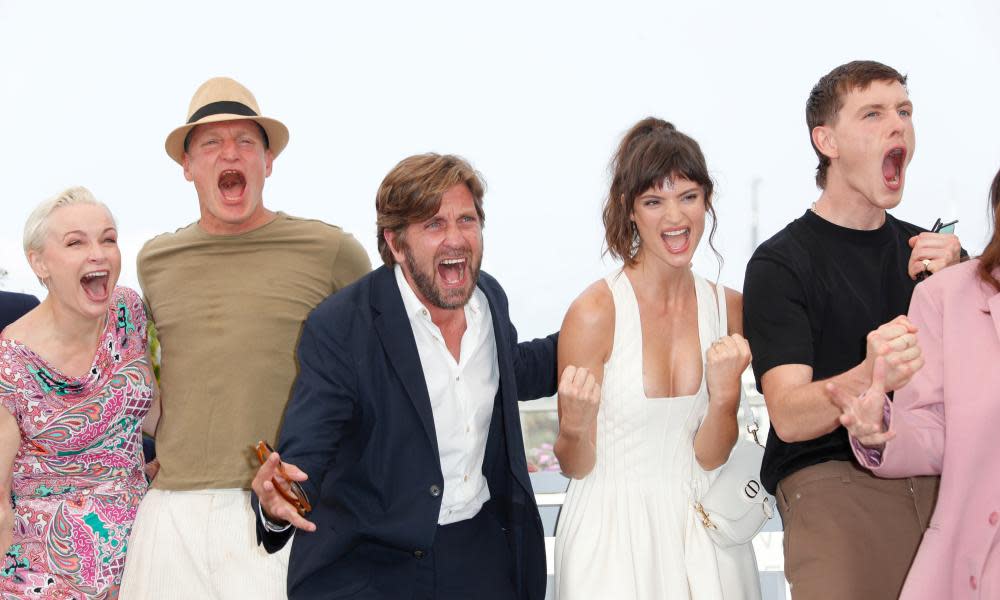‘The end of western civilisation’: Triangle of Sadness director explains modelling world satire

The shrieks of delight and horror greeting Ruben Östlund’s latest film, Triangle of Sadness, are a mark of success for its award-winning Swedish director, he said on Sunday, following the film’s Cannes festival premiere. Östlund explained he intended to make a “rollercoaster experience” for adults.
“People were applauding like it was a football game,” said Östlund.
Related: The Triangle of Sadness review – heavy-handed satire on the super-rich loses its shape
Östlund, best known for his 2014 alpine drama Force Majeure, which was remade in English two years ago as Downhill, may also have ably succeeded in establishing the status of his young British star, Harris Dickinson, with this new film. Dickinson, 25, from Leytonstone, east London, carries much of the narrative of a film which also features copious amounts of vomit and diarrhea – and yet has earned the longest audience ovation of the festival so far (eight minutes).
In the role of a male model, Carl, who is in a relationship with a supermodel influencer, Dickinson said he had to allow himself to be treated as a “piece of meat” in the drama, but joked he would have happily accepted the role of the donkey, an animal who comes to a sticky end in the film, so keen was he to work on the project.
With a title that refers to the unwelcome frown zone on a model’s forehead, Triangle of Sadness is a vicious satirical attack on the warped but perhaps inevitable social power of beauty and wealth. Östlund described the film’s original pitch as for a story that “starts the fashion world, goes on to a luxury yacht and ends on island, and where we are going to see how the models use their looks as currency throughout. It is going to be the end of the western civilisation.”
For shock impact,Triangle of Sadness may have pre-empted the thunder of David Cronenberg’s Crimes of the Future, which premieres in Cannes on Monday and for which the director has already predicted audience walkouts.
Östlund, 48, from Gothenberg, who won the Palme d’Or at Cannes with his art world satire The Square, acknowledged that his latest film has disappointed some critics with its broad humour and deliberate bad taste, but said he was delighted by audience responses.
“At the premiere and in our test screenings outside the cities, in the countryside in Spain, for example, people were laughing and screaming straight out. We urban Europeans are not a good audience. We sit with our arms crossed, It had been my goal to play it like a rollercoaster for adults, to use the cinema for what it should be used for. Not for watching in a smart way.”
The director added that he had aimed to create a blend of the European cinema tradition, “of trying to say something about society”, with the productive American habit of making films that are driven by the need to please audiences and make money.
Some critics have hailed it as one of the best films of the festival so far.
Östlund’s cast of actors, including Woody Harrelson, as a drunken Marxist yacht captain, were all asked to improvise and to regularly endure 25 takes for each shot.
Harrelson, 60, in Cannes for the premiere, said that he did not identify closely with the role he played because while the character is a Marxist, he is an anarchist. He then ventured his own risky joke, inspired by President George W Bush’s recent gaffe about the Russian invasion of Ukraine: “I am the kind of guy who thinks it is abominable when a country, a country with all this military, a superpower, attacks just unprovoked a county like Ira...Afgha...Vietna...No, sorry lost my way there.”
But the American star raved about working with Östlund on the film.
“He can make you extremely uncomfortable and make you think. He makes you laugh throughout, perhaps more importantly, which is quite a trick. I am going to be in his next film whether he wants me or not. It was a revitalising experience, one of the greatest experiences of my life.”
Östlund said he had chosen to examine the fashion industry because of conversations with his wife, a fashion photographer, and his interest in the way fashion commercialises the human instinct to find security in the look of the herd.
Dickinson said he felt his character in the film played a knowing part in this economy: “He very much knows where he stands and he uses his looks to his advantage. Ruben makes incredibly astute observations about human behaviour and picks holes in all our egos. I had to allow myself to be pathetic and offer myself up as a piece of meat. That is what works and what gets Karl forward.”

 Yahoo Movies
Yahoo Movies 
